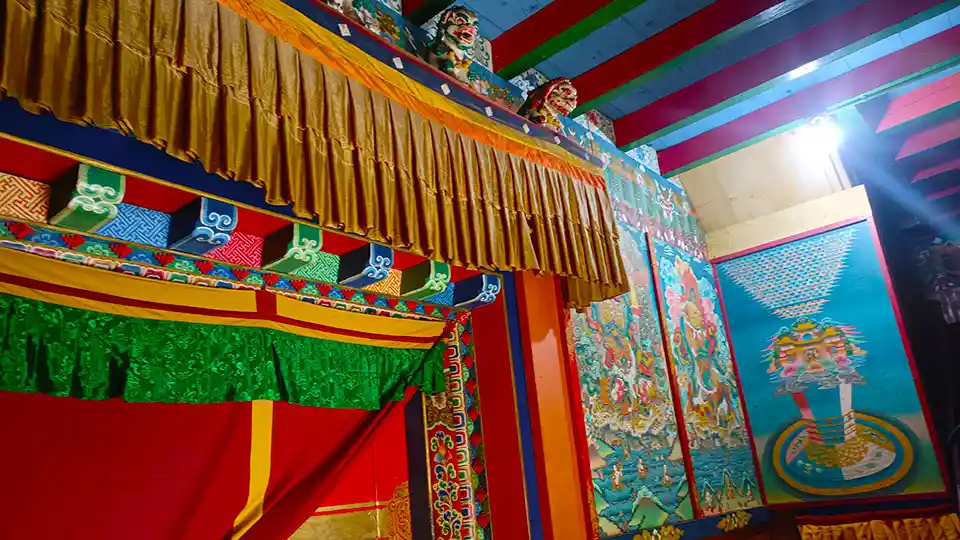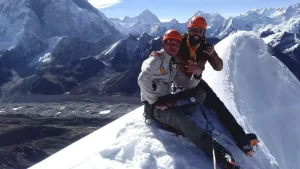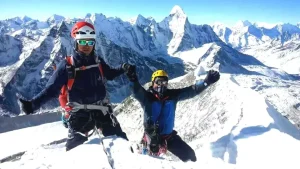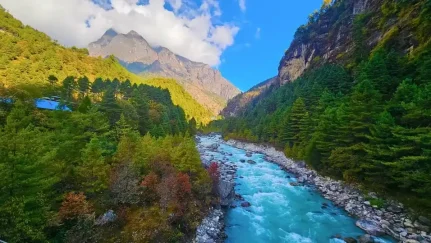For many people, trekking in the Everest region is their dream. A noteworthy portion of the Everest Base Camp trip is the route from Tengboche to Dingboche, which presents hikers with a mix of breathtaking landscapes, unique cultural encounters, and tough physical terrain. This section, which is roughly 10 kilometers long and typically takes five to six hours, travels from the well-known Tengboche Monastery via a variety of scenery to the charming settlement of Dingboche. This book will examine every facet of the trip in great detail and offer insightful commentary to enhance your hiking adventure.
Some key details Tengboche to Dingboche :
- Route Overview from Tengboche to Dingboche:
- Distance: Approximately 10 kilometers (6.2 miles)
- Elevation Gain: Tengboche (3,860 meters) to Dingboche (4,410 meters)
- Duration: 5-6 hours of trekking
Tengboche: Historical and Cultural Importance:
The Beginning Famous for the Tengboche Monastery, the largest gompa in the Khumbu region.
At 3,860 meters, Tengboche is a location steeped in soul and historical events, not just a place to stop for the walk. Trekkers and climbers congregate at the largest monastery in the Khumbu region, Tengboche Monastery. It was first constructed in 1916, but flames and other disasters have caused it to be reconstructed several times. The monastery provides a rare chance to observe Buddhist monks going about their everyday lives and learn about their way of life. Stunning views of Mount Everest, Lhotse, Nuptse, Ama Dablam, and Thamserku.
Trail Description:
- The trek starts with a descent through a rhododendron forest to Debuche.
- Cross the Imja Khola River via a suspension bridge.
- Gradual ascent to Pangboche, the highest permanent settlement in the region.
- Continue the ascent to Shomare, a small settlement where you can rest and have lunch
- Thanka painting in Tengboche Monastery
Getting Ready:
Make sure you are ready before you leave. Acclimatization is essential because the hike gains a lot of height. Make sure your hiking equipment is in good working order, carry basic supplies like water, food, and a first aid kit, and drink enough of water.
Beginning of the Trek: Tengboche to Debuche Descent Via the Forest:
There is a descending across a verdant rhododendron woodland to start the trek from Tengboche. This portion of the trip is very easy and gives you an opportunity to take in the area’s natural splendor. The rhododendrons blossom in the spring, bringing brilliant hues to the surroundings.
Getting across the Imja Khola
You descend through the forest to the small town of Debuche, which is home to a nunnery. After that, a suspension bridge takes you over the Imja Khola River. One of the numerous exhilarating suspended bridges in the Everest region, it provides breathtaking views of the nearby peaks and the waters underneath.
Plant and Animal Life
There is a lot of wildlife in this section of the hike. Watch for a variety of bird species and occasionally catch a sight of fauna like Himalayan tahr and musk deer. As you ascend, the flora shifts from lush forests to increasingly sparse plants.
climbing up to Pangboche.
Steep Ascent
Following the river crossing, the trail begins to progressively climb in the direction of Pangboche. The continuous ascent and rising altitude make this section of the hike more difficult. But the trail is well-traveled and has many of places to stop and enjoy the scenery.
Village of Pangboche.
The highest long-term community in the area is Pangboche, which is situated at 3,985 meters. It’s a great spot to take a break and have lunch. The Pangboche Monastery, the oldest in the Khumbu region, is located in the settlement and is well worth a visit. In addition to preserving antiquated artifacts, the monastery provides insight into the customs and religious beliefs of the region.
Engaging with the Community
Pangboche’s Sherpa community is renowned for their warmth. Talking to the locals can provide you an understanding of their customs, daily routines, and the difficulties of living at a high altitude. Numerous residents have extensive mountaineering and guiding experience, and they frequently share amazing tales of their travels.
The Continued Gradual Ascent Path to Shomare:
After leaving Pangboche, the route progressively climbs higher. There are less trees at this section of the walk, making the scenery more open and offering sweeping views of the valleys and mountains. The ascent becomes more difficult as the air becomes thinner.
Shomare: A Stopover for lunch between Tengboche to Dingboche
The tiny community of Shomare is a crucial resting place for hikers. Situated at an approximate elevation of 4,010 meters, it offers a chance to rest, rehydrate, and eat a small lunch. Basic facilities are provided by the teahouses here, and Shomare offers stunning views of the skyline dominated by Ama Dablam.
The Value of Nutrition and Hydration
It’s critical to maintain adequate diet and hydration at higher elevations. Dehydration can worsen the symptoms of altitude sickness, as can the dry air and physical activity. Bring along energy-boosting treats such as chocolate, nuts, and dried fruits, along with adequate water.
Last Mile to Dingboche.
The Ascent Gets Steeper.
After leaving Shomare, the route gets steeper and trickier. There are fewer indications of flora and more stony areas in the changing environment. Because of the physical demands of the climb, pace yourself and take frequent pauses.
- Yak Carrying Goods
Arriving at Dingboche.
It takes several hours of continuous rising to reach Dingboche, which is located at 4,410 meters. The picturesque village of Dingboche is distinguished by its fields with stone walls that shield crops from the strong winds. Magnificent peaks such as Island Peak, Ama Dablam, and the Imja Valley encircle the settlement.
Getting used to it.
Trekkers often use Dingboche as a stop for acclimatization. It’s best to stay an extra day here to get acclimated. There are a number of small walks in and around Dingboche, like the ascent to Nagarjun Hill, which provides sweeping vistas and aids with acclimatization.
Investigating Dingboche.
Regional Culture.
Dingboche provides an insight into the customs of the Sherpa people. Trekkers can unwind and socialize with the locals in the village’s many teahouses and hotels. The Sherpa people are well known for their hospitality, and their tales of the mountains give the journey a special cultural twist.
Scenery Views
Some of the nicest views in the area may be found in Dingboche. Especially beautiful are the sunrises and sunsets over the mountains. Trekkers can take short hikes, explore the surrounding places, and snap pictures to preserve the beauty of the environment.
Safety and Health
You must keep a careful eye on your health at high altitude. It’s important to pay attention to altitude sickness symptoms like headaches, nausea, and dizziness. Eat healthful meals, drink lots of water, and get lots of sleep. It is imperative to descend to a lower altitude if symptoms continue.
Final Words Dingboche: A picturesque village with stone-walled fields and panoramic mountain views.
Known as a popular acclimatization stop for trekkers.
Offers splendid views of Ama Dablam, Island Peak, and the Imja Valley.
In summary the trail from Tengboche to Dingboche
Trekking over some of the most breathtaking scenery in the Everest region, from Tengboche to Dingboche, is an unforgettable experience. Every step brings something new, from the serene atmosphere of Tengboche Monastery to the gorgeous meadows of Dingboche. A successful and pleasurable journey requires careful planning, acclimatization, and respect for the local environment and culture. This section of the Everest Base Camp walk offers insights into the natural beauty and cultural diversity of the area in addition to being a strenuous physical endeavor. It is an adventure across the core of the Himalayan Mountains.
















